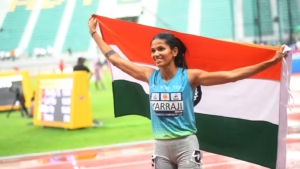For decades, Indian shooting success on the world stage was defined by performances in the 10m Air Rifle and 25m Rapid Fire Pistol events.
The 50m Rifle 3 Positions (3P), often considered the most complex and demanding rifle discipline, remained a persistent blind spot. Until 2023, India had not won a single individual global medal no Olympic podium, no World Championship medal in either the men’s or women’s 3P events.
Read Articles Without Ads On Your IndiaSportsHub App. Download Now And Stay Updated
From a historical baseline of zero, India surged to three major global medals between 2023 and 2024—an exceptional leap powered by strong systems, deep coaching continuity, and a new generation of technically matured shooters. By every metric, the 50m Rifle 3 Positions has become India’s most improved high-performance shooting category.
A Discipline That Tests Everything
Unlike the precision-driven 10m Air Rifle, the 50m 3P is a brutal test of endurance, technique, and psychological strength. Athletes shoot 60 shots across kneeling, prone, and standing, with each position demanding different physical and technical abilities. Standing, especially, is the great separator an 8kg rifle, no support, and enormous pressure.
Historically, Indian shooters struggled in the event for two major reasons:
- Technical inconsistency across positions
- Difficulty sustaining elite precision over a 90-minute match
Before 2023, these challenges stopped India from breaking through at the world’s biggest stages. What changed was not a single athlete it was the entire system.
The Medal Breakthrough: 0 → 3 in Two Years
The transformation began with Akhil Sheoran’s bronze at the 2023 World Championships in Baku. Months later, Aishwary Pratap Singh Tomar elevated India into genuine world-class territory by winning silver at the ISSF World Championships, equalling the world record qualification score with a stunning 597/600.

The crowning moment arrived at the Paris 2024 Olympic Games, when Swapnil Kusale delivered India’s first-ever Olympic medal in the 3P event a historic bronze that broke a 72-year drought in the men’s category.
Three different shooters. Three major medals. One unmistakable trend: systemic success.
Why 3P Is India’s Most Improved Category
Apart from the three global medals, several structural indicators confirm this discipline’s rise:
World-Class Scoring Depth
- Tomar equalled the world record (597/600).
- Sift Kaur Samra set the Women’s 3P Final World Record at the Asian Games (469.6).
- Sift’s 598/600 (National Games) even surpassed the women’s world record.
This kind of raw scoring depth across both genders is unprecedented.
Maximum Olympic Quotas: India secured the maximum two quotas in men’s 3P for Paris 2024 something only the world’s elite traditionally achieve.
Consistent Final Appearances: Multiple shooters Tomar, Kusale, Sheoran, Sift, Niraj Kumar regularly finish inside the world’s top eight at World Cups, Asian Championships, and World Championships. The quantity and quality of performances confirm that India’s rise is not a one-athlete phenomenon it is the outcome of a decade of systemic building.
The Coaching Foundation: A Decade of Continuity
At the heart of this transformation is Deepali Deshpande, Dronacharya Awardee and former Olympian, who has shaped India’s rifle ecosystem since the early 2010s. As Head Coach of the rifle team, her long-term mentorship of Swapnil Kusale, whom she began training in 2013, exemplifies India’s shift to indigenous, long-term coaching cycles. Alongside Deshpande, Manoj Kumar, the high-performance 50m rifle coach, has driven technical refinement and competition readiness.
For the first time, India has a coaching structure built on consistency rather than frequent turnover—vital for a discipline as complex as 3P.
Read Articles Without Ads On Your IndiaSportsHub App. Download Now And Stay Updated
India’s 3P revolution is also rooted in accessibility. Contrary to the once-prevailing belief that shooting is an elite sport, today’s stars come from diverse backgrounds:
- Swapnil Kusale hails from a farming family and came up through Krida Prabhodini, a state-run programme.
- Institutional employers like Railways and NGOs have funded training and competition exposure.
This wider talent pipeline ensures India is not just producing champions but building a sustainable ecosystem.
Sports Science, Technology, and Mental Conditioning
Modern 3P success depends on managing micro-details trigger discipline, muscle stability, breathing patterns, and especially standing-position control. India has stepped up significantly in:
- Optoelectronic aiming analysis
- Standing-position biomechanics
- Pressure training simulations
- Mental conditioning
Athletes like Anjum Moudgil have even pursued degrees in sports psychology to support performance refinement. This integrated science-based approach has lifted national standards across the board.
India’s goal is clear: convert bronze and silver into gold at the LA 2028 Olympics. To get there, the system must:
- Retain its core domestic coaching leadership
- Expand high-performance infrastructure for 3P
- Continue athlete-specific technical and mental conditioning
- Build depth across next-generation shooters
With three global medals already in the bag and a technical foundation stronger than ever, India’s 50m Rifle 3 Positions programme stands as the country’s biggest high-performance shooting success story of the last decade.
How useful was this post?
Click on a star to rate it!
Average rating 0 / 5. Vote count: 0
No votes so far! Be the first to rate this post.






